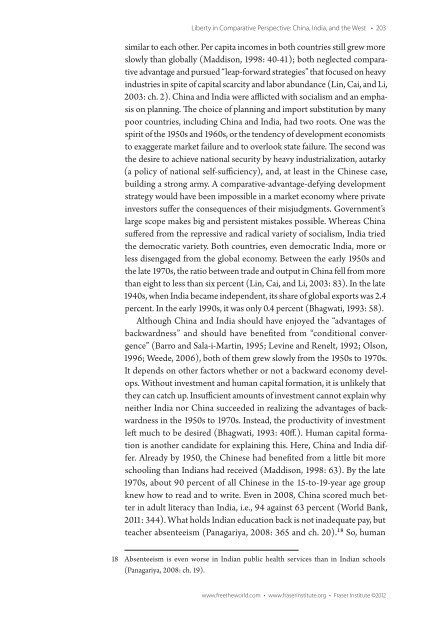Towards a Worldwide Index of Human Freedom
Towards a Worldwide Index of Human Freedom
Towards a Worldwide Index of Human Freedom
You also want an ePaper? Increase the reach of your titles
YUMPU automatically turns print PDFs into web optimized ePapers that Google loves.
Liberty in Comparative Perspective: China, India, and the West • 203<br />
similar to each other. Per capita incomes in both countries still grew more<br />
slowly than globally (Maddison, 1998: 40-41); both neglected comparative<br />
advantage and pursued “leap-forward strategies” that focused on heavy<br />
industries in spite <strong>of</strong> capital scarcity and labor abundance (Lin, Cai, and Li,<br />
2003: ch. 2). China and India were afflicted with socialism and an emphasis<br />
on planning. The choice <strong>of</strong> planning and import substitution by many<br />
poor countries, including China and India, had two roots. One was the<br />
spirit <strong>of</strong> the 1950s and 1960s, or the tendency <strong>of</strong> development economists<br />
to exaggerate market failure and to overlook state failure. The second was<br />
the desire to achieve national security by heavy industrialization, autarky<br />
(a policy <strong>of</strong> national self-sufficiency), and, at least in the Chinese case,<br />
building a strong army. A comparative-advantage-defying development<br />
strategy would have been impossible in a market economy where private<br />
investors suffer the consequences <strong>of</strong> their misjudgments. Government’s<br />
large scope makes big and persistent mistakes possible. Whereas China<br />
suffered from the repressive and radical variety <strong>of</strong> socialism, India tried<br />
the democratic variety. Both countries, even democratic India, more or<br />
less disengaged from the global economy. Between the early 1950s and<br />
the late 1970s, the ratio between trade and output in China fell from more<br />
than eight to less than six percent (Lin, Cai, and Li, 2003: 83). In the late<br />
1940s, when India became independent, its share <strong>of</strong> global exports was 2.4<br />
percent. In the early 1990s, it was only 0.4 percent (Bhagwati, 1993: 58).<br />
Although China and India should have enjoyed the “advantages <strong>of</strong><br />
backwardness” and should have benefited from “conditional convergence”<br />
(Barro and Sala-i-Martin, 1995; Levine and Renelt, 1992; Olson,<br />
1996; Weede, 2006), both <strong>of</strong> them grew slowly from the 1950s to 1970s.<br />
It depends on other factors whether or not a backward economy develops.<br />
Without investment and human capital formation, it is unlikely that<br />
they can catch up. Insufficient amounts <strong>of</strong> investment cannot explain why<br />
neither India nor China succeeded in realizing the advantages <strong>of</strong> backwardness<br />
in the 1950s to 1970s. Instead, the productivity <strong>of</strong> investment<br />
left much to be desired (Bhagwati, 1993: 40ff.). <strong>Human</strong> capital formation<br />
is another candidate for explaining this. Here, China and India differ.<br />
Already by 1950, the Chinese had benefited from a little bit more<br />
schooling than Indians had received (Maddison, 1998: 63). By the late<br />
1970s, about 90 percent <strong>of</strong> all Chinese in the 15-to-19-year age group<br />
knew how to read and to write. Even in 2008, China scored much better<br />
in adult literacy than India, i.e., 94 against 63 percent (World Bank,<br />
2011: 344). What holds Indian education back is not inadequate pay, but<br />
teacher absenteeism (Panagariya, 2008: 365 and ch. 20).18 So, human<br />
18 Absenteeism is even worse in Indian public health services than in Indian schools<br />
(Panagariya, 2008: ch. 19).<br />
www.freetheworld.com • www.fraserinstitute.org • Fraser Institute ©2012


